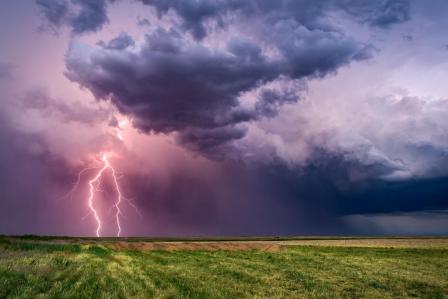EPA Model Shows Potential in Unraveling the Mystery of Lightning’s Impact on Air Quality
 EPA researchers are unraveling the mystery of lightning's impact on air pollution. Published September 28, 2020
EPA researchers are unraveling the mystery of lightning's impact on air pollution. Published September 28, 2020
Summer storms can often bring a lightning show in the sky, but did you know that these giant sparks of electricity in the atmosphere can also contribute to the levels of ozone we breathe?
In a study published in Nature Partner Journal, EPA researchers used the Community Multi-scale Air Quality (CMAQ) modeling system to simulate the impact lightning has on ground-level ozone across the continental United States. CMAQ is used by the Agency and states to obtain fast and technically sound estimates of air pollutants for use in air quality management.
In a lightning storm, each flash produces nitrogen oxide (NOx), a mixture of air pollutants that are also emitted by motor vehicles and industrial sources. These reactive gasses play a major role in the development of ozone. For this reason, modelers want to better understand the impact natural sources of NOx, such as that from lightning, have on ozone levels so that they may improve the air quality predicting capabilities of CMAQ.
EPA researchers used an updated lightning NOx emission estimation algorithm in the CMAQ model, combined with previously gathered lightning flash data from the National Lightning Detection Network, to broaden their understanding of lightning’s potential impact on ground-level ozone. They analyzed lightning flash data over the mountain west states – an area where human-generated NOx emissions are low and lightning strikes are high, during the summer of 2011. Researchers found that lightning-related NOx over the period studied significantly impacted the region, with average monthly contributions to the total NOx budget of 30 percent (in these areas of low human-generated NOx). This results in an overall increase to ozone levels, though the impact on specific ozone nonattainment events at urban and suburban areas needs further investigation.
Ozone has continued to be a primary focus in air quality research because of the risk it can pose to human health and the environment. As regulatory measures and technological advances reduce NOx emissions from human activity, the relative contributions of lightning-related NOx to ground-level ozone may increase, even as overall ozone levels may decline. Therefore, accurate quantification of lightning NOx emissions, their contribution to background ozone levels, and their role in affecting air quality over different regions are becoming more important.
Large uncertainties have been associated with lightning strikes and lightning-related NOx in air quality models in the past. However, the CMAQ modeling system is showing promise in addressing this challenge.
“As a 3D multi-scale chemical and transport air quality model, CMAQ is an excellent tool to assess the impact of lightning-related NOx on air quality. CMAQ has been improved by implementing algorithms to use lightning data at finer spatial and temporal resolutions,” says EPA researcher Daiwen Kang, lead author on the published study.
This research highlights just how powerful this tool can be in tackling current unknowns contributing to air quality issues. It is only the beginning in an exciting venture to fully understand and properly measure lightning’s impact on ground-level ozone, which will ultimately aid states in efforts to help protect our air quality.
Learn More
